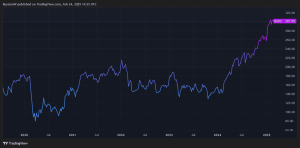Nvidia (NASDAQ: NVDA) stock has been a staggering outperformer over many timeframes you’d care to mention. One year? Up 70%. Five years? Up more than 1,700%. And 10 years? More than 23,000% higher!
But in the past single, solitary month, the Nvidia share price is down 8.7%. This means a £10,000 investment made in late January is now worth about £9,125 on paper.
Why is the stock down?
Nvidia’s graphics processing units (GPUs) have become absolutely integral to the generative artificial intelligence (AI) revolution. They process many tasks in parallel, thereby accelerating the training and inference of AI systems.
Tech firms across the world have been snapping up as many as they can lay their hands on. This massive demand, coupled with a struggle to manufacture them quickly enough, has seen the chipmaker’s pricing power, earnings, and margins go through the roof.
However, nearly a month ago, the share price bombed 17% in a day due to a little-known AI developer called DeepSeek. It released a free, open-source large language model (LLM) that it claims cost less than $6m to build with Nvidia’s less powerful chips.
This worried the market because Nvidia’s growth story is based on the assumption that cutting-edge LLMs will forever need the most powerful (and expensive) chips. DeepSeek’s arrival raised questions about the long-term sustainability of compute demand and the scale of capital investment in GPUs.
Is this anything to worry about?
Nvidia’s share price is only 10% off an all-time high. So investors don’t appear overly concerned about this issue. Indeed, CEO Jensen Huang reckons more efficient models could accelerate the adoption of AI, driving even more demand for GPUs. That’s certainly a plausible scenario.
The company reports Q4 earnings after the US market closes on Wednesday (26 February). It’s expected to post revenue of $38bn and earnings per share (EPS) of $0.84.
One thing investors will be keen to hear about is the firm’s latest flagship AI chip (Blackwell). This is now being shipped to major cloud-computing customers. Last we heard, demand for Blackwell chips was “insane” (according to Huang) and “staggering” (according to the CFO).
Personally, I wouldn’t be surprised if Nvidia beats Q4 expectations and forecasts a strong Q1. However, it’s worth noting that the stock’s down 7% since the last (excellent) Q3 report in November. It’s started to drift, as if in search of a new catalyst.
Long-term thinking
Someone thinking about investing in Nvidia should be confident about rising demand for its GPUs over the long term. If that continues to be strong, then the stock’s worth considering because it currently trades on a reasonable forward price-to-earnings (P/E) ratio of 29. That then falls to just 24, based on forecasts for FY 2027 (which starts in February 2026).
But the issue for me is whether demand will start to finally wane as we head into 2026 and 2027. If so, the company’s sales and earnings growth could slow dramatically.
Moreover, three companies — widely thought to be Microsoft, Meta, and Alphabet — made up 36% of Q3 revenue. So customer concentration is a risk, with Nvidia vulnerable to a lowering of AI spending from these tech giants. They’re all designing their own custom AI chips as well to reduce reliance on Nvidia’s.
Due to this uncertainty, I’m not going to invest today.
This post was originally published on Motley Fool







